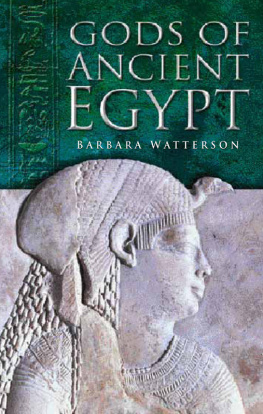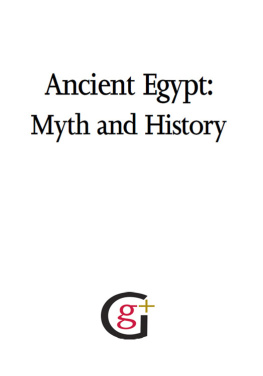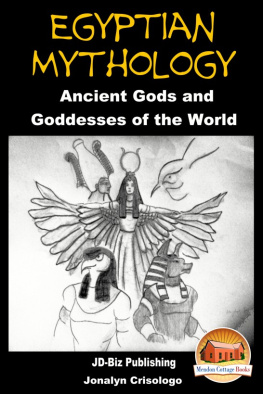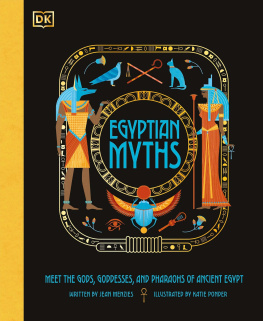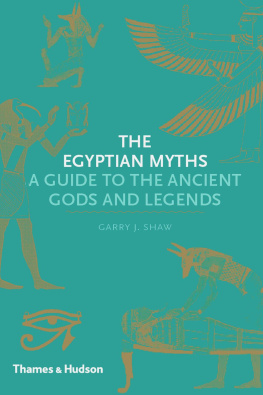GODS OF ANCIENT EGYPT
For Alice and Lily
GODS OF ANCIENT EGYPT
BARBARA WATTERSON

First published in 1984 by Batsford Academic and Educational a division of B.T. Batsford Ltd
First published by Sutton Publishing Limited in 1996
This edition first published in 2003
The History Press
The Mill, Brimscombe Port
Stroud, Gloucestershire, GL5 2QG
www.thehistorypress.co.uk
This ebook edition first published in 2013
All rights reserved
Barbara Watterson, 1984, 1996, 2003 2013
The right of Barbara Watterson to be identified as the Author of this work has been asserted in accordance with the Copyrights, Designs and Patents Act 1988.
This ebook is copyright material and must not be copied, reproduced, transferred, distributed, leased, licensed or publicly performed or used in any way except as specifically permitted in writing by the publishers, as allowed under the terms and conditions under which it was purchased or as strictly permitted by applicable copyright law. Any unauthorised distribution or use of this text may be a direct infringement of the authors and publishers rights, and those responsible may be liable in law accordingly.
EPUB ISBN 978 0 7524 9502 6
Original typesetting by The History Press
CONTENTS
ACKNOWLEDGEMENTS
I should like to thank my husband, Juan, for his constant support and encouragement in the production of this book.
PREFACE
The artefacts of the ancient Egyptian civilization, from the largest temples to the smallest amulets, have been much admired for their beauty and workmanship. Admiration soon leads to curiosity about the purpose or significance of certain themes and designs, many of which consist of ever-recurring religious symbols and images of gods in different guises. A knowledge of the more commonly represented deities allows the admirer to understand something of the purpose and motives which directed the skills of ancient Egyptian artisans.
In assembling this gazetteer of the gods of ancient Egypt, I have aimed at introducing only the thirty or so more important members of a tribe numbered in hundreds, and in addition to more factual details of form, time and place have related the sometimes elaborate mythology pertaining to each. These mythologies are the ancient Egyptian version of the folklore and fairy stories which all societies produce. Throughout the book, references have been given to sources in which translations of the various myths and stories can be found; however, excerpts quoted in the book are from my own translations.
This book is not a study of ancient Egyptian religion as such, and the only purpose of the brief introductory chapters is to allow the reader to appreciate the theological context in which the gods were worshipped. No attempt has been made to make comparisons with the gods or beliefs of other cultures, although any description of a culture different from our own, especially one so far removed from us in time, inevitably incorporates implicit and sometimes very subjective comparisons with our own twenty-first century European tribal customs and beliefs.
The origins and chief places of worship of certain ancient Egyptian deities, and the beliefs associated with them, are set out .
A NOTE ON TRANSLITERATION
From about 3100 BC, the Egyptian language was written in hieroglyphic script, a decorative and complex picture-writing that remained in use for over 3,000 years. In 30 BC, Egypt came under Roman rule. The Romans abolished the institution of monarchy in Egypt; and the dissolution of what had been the linchpin of Egyptian society, combined with the advent of Christianity, to which most of Egypt had been converted by the fourth century AD, meant that the use of hieroglyphs, and the alternative scripts, hieratic and demotic (see ), fast deteriorated, to be replaced by Greek, and by Coptic, the last stage of the native language of Egypt, which employed the Greek alphabet as the basis of its written script.
The language of ancient Egypt, as expressed in hieroglyphs, hieratic and demotic, was lost for centuries until, in AD 1822, Jean-Franois Champollion became the first man of modern times to decipher hieroglyphs correctly. However, the pronunciation of ancient Egyptian is not known with a sufficient degree of certainty.
In order for an English-speaker, for example, to be able to read hieroglyphic script, the pictographs used in it have to be turned into an approximation of the English alphabet, that is, transliterated. Unfortunately, the Egyptians only used consonants in their written script; their language must have had vowels in it, but the position of these vowels in Egyptian-language words is not made clear in hieroglyphic script. It should perhaps be mentioned here that the official language of Egypt today is Arabic, and has been since the Arab Conquest of AD 640; and that Arabic is not the same language as ancient Egyptian, although the script of both has one thing in common: in neither language are the vowels written.
Thus, there are schools of transliteration for both languages with ), the word has been rendered into an approximation of English, sn being written shen.
CHRONOLOGICAL TABLE
It is customary to arrange ancient Egyptian history into dynasties, or groups, of kings, following the system first used by the third-century BC scholar-priest, Manetho, in his history of Egypt, written in Greek and entitled the Aegyptiaca. To the end of Manethos original list have been added two dynasties to cover the years after his death. The thirty-two dynasties thus arrived at are divided into periods known as Old Kingdom, Middle Kingdom and New Kingdom, interspersed with so-called Intermediate Periods. The term Kingdom is not a geographical description but is historical and refers to the times in ancient Egyptian history when the country was a unified state ruled by one king. The Intermediate Periods were times when there was no strong central government.
Since we are not certain of how ancient Egyptian was pronounced, many scholars prefer to use the Greek forms of royal names taken from Manetho. In the following table, both Greek and Egyptian forms are given where appropriate; in the book, the Egyptian form is used, so that it can be seen clearly which kings are named after gods.
prehistory: i.e. Predynastic Egypt c. 5500c. 3150 bc
Lower Egypt: | 55004000 BC:
Fayum and Merimde cultures |
Upper Egypt: | 55004000 BC:
Badarian culture |
Upper Egypt: | 40003500 BC:
Naqada I culture |
Upper Egypt: | 35003150 BC:
Naqada II culture |
protodynastic period:
Next page
